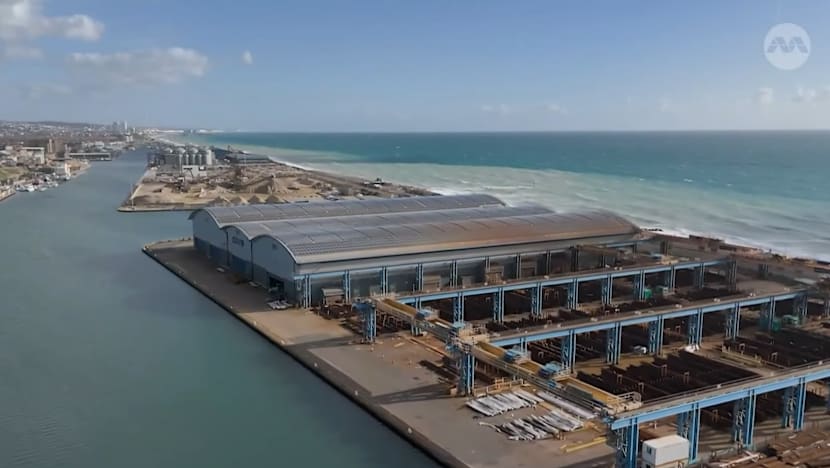Solar power rises above policy, weather headwinds in the US and UK
Growing energy demand and falling technology costs are fuelling a boom in the solar power industry on both sides of the Atlantic.


This audio is generated by an AI tool.
STONINGTON, United States / WEST SUSSEX, United Kingdom: In the American state of Connecticut, one farmer is betting big on solar energy to diversify his income.
Eric Taylor is leasing a portion of his land to a solar operator, with construction set to finish early next year. He envisions the panels coexisting with his livestock, generating both clean energy and revenue.
“We need energy in this country and whether it's subsidised or not, it's all going to have an impact on the environment,” he noted.
“I think solar, at this point in time, is one of the lower-impact ways to go.”
From Connecticut’s farmlands to the beaches of West Sussex on the other side of the Atlantic, solar innovators are finding ways to adapt to changing markets and technologies.
Despite political and logistical hurdles, the industry continues to thrive in both the United States and the United Kingdom - driven by rising energy demand and falling technology costs.
DEFYING TRUMP’S CUTBACKS
Since US President Donald Trump returned to office in January, his administration’s energy policies have cast dark clouds over the country’s renewable energy industry.
The US is not participating in this year's United Nations’ Climate Change Conference (COP30), and Trump has continued to slam green energy initiatives, recently dismissing climate change as a “con job”.
The One Big Beautiful Bill legislation – passed in July – did away with federal subsidies that had nurtured the solar and wind power sector for decades.
But many solar projects are defying the cutbacks.
The Energy Information Administration – a principal agency of the US Federal Statistical System responsible for collecting, analysing and disseminating energy information – expects solar to supply the largest share of predicted US power demand increases in 2025 and 2026.
While some of the solar boom can be chalked up to a rush to build before the incentives fully expire, experts say solar is here to stay.
“We have been saying solar is economic even without the tax credits,” said Sylvia Martinez, research director at consulting firm Wood Mackenzie.
“What is happening now is rethinking how to do business without tax credits, so it's more of a shift in market dynamic.”
“VERY CHALLENGING” TIMES
One big shift is an unprecedented need for more power.
Electricity demand in the US is projected to keep rising, fuelled in part by the explosive growth of AI data centres.
Solar, which currently accounts for about 7 per cent of electricity generation in the US, is one of the fastest ways to add power to the grid. But issues like grid compatibility can slow things down.
On top of that, Trump’s sweeping tariffs, as well as shifting regulations over which countries can supply components to the US, have created uncertainty in what industry veterans call the “solar coaster”.
Ryan Linares, vice president of real estate at renewable energy solutions company Greenskies Clean Focus, called it a “very challenging” way to do business.
“If we could take politics out of it, we know what our runway is and we know what the rules are of the game. I think solar wins every time,” he added.
Experts are also watching how the end of subsidies could reshape US solar project financing.
“It's an economic incentive the investment community has come to rely on. It makes it a secure, predictable investment,” noted Kirk Mayland, visiting professor at Vermont Law and Graduate School’s Institute for Energy and the Environment.
He pointed out that this will change without solar tax credits, adding: “It's going to fundamentally alter the way people look at the industry.”
As the world’s second-largest emitter of greenhouse gases, the US plays a pivotal role in global climate outcomes.
Advocates say that if the country’s solar industry can withstand current challenges, it still has the potential to drive the transition needed to avert the worst impacts of climate change.
UK’S TIME TO SHINE
Across the Atlantic, Britain’s solar industry is basking in its own moment in the sun.
This year has been the brightest for British solar power on record. A particularly sunny year, coupled with multiple new solar arrays, meant that 40 per cent of the country’s electricity came straight from the sun at one point in May.
“I think the other big thing is we've reduced the amount of air pollution in the UK quite rapidly,” noted Iain Staffell, associate professor in sustainable energy at Imperial College London.
An improvement in vehicle and ship emissions means the UK’s skies are “clearer than they have been for decades”, he added.
The UK government wants Britain to be a “clean energy superpower” and generate 95 per cent of its electricity from low-carbon sources by 2030.
Despite the country’s infamously gloomy weather, authorities believe nearly a quarter of that electricity can come from the sun.
But ultimately, solar only provides 6 per cent of Britain’s total annual energy production on average – similar to the US.
The UK government’s proposed solution lies in more battery storage and more solar panels.
The country is in the middle of a “second boom” of solar after the first wave in the early 2010s, noted William Delabre, technical director of solar at Natural Power, an independent consultancy and service provider for the renewable energy sector.
“Solar is accelerating like never before within the UK. Developers are just urging grid planning authorities to let them connect (and) build as quickly as possible,” he added.
Britain’s solar capacity currently peaks at about 20 gigawatts (GWs) under perfectly sunny conditions.
The target by 2030 is to capture at least 45 GWs – enough to power 9 million homes.

“The capacity of assets currently looking to connect to the network is in the range of 700GW. For context, that is equivalent to the size of the existing network in the country,” said Avinash Aithal, strategic programme director at the Energy Networks Association, an industry body for energy network operators in the UK and Ireland.
“In effect, if we are going to be meeting the targets, we are going to have to double the size of our networks.”
SOLAR POWER FROM SPACE
In addition to expanding its grid and terminating stalled solar projects, the UK is also investing in futuristic ideas – like solar power from space.
The concept involves solar panels orbiting Earth, constantly exposed to sunlight and providing power for any location in need.
“(Panels in space are) generating about 13 times the amount of energy that the same panel does on Earth because there's no atmosphere, no weather,” said Martin Soltau, co-CEO of Space Solar.
The British startup has received government funding to make space-based solar power a reality.
“It's really, for decades, been considered technically viable but just too expensive, and that's because a high percentage of the capital cost is launching this stuff,” added Soltau.
But launch costs have dropped over the last eight years, he added.
Space Solar’s first prototype is expected to launch by 2030, with commercial operations planned five years later. Advocates say the potential could make space the final frontier for solar power.


















